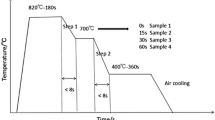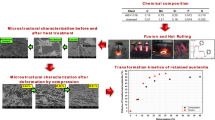Abstract
The influence of plastic deformation on the elastic properties that determine the magnitude of springback following forming was investigated using dynamic modulus analysis. For this study, the elastic modulus of TRIP 700 steel was measured continuously at 35 °C and a loading frequency of 1.0 Hz for 1000 min following deformation by cold rolling to varying levels up to 27%. The elastic modulus increased at an exponentially decaying rate during these experiments and with a magnitude that increased with pre-strain. These observations are consistent with the hypothesis that deformation creates microstructural defects that contribute compliance when the stress state changes and that these defects are removed by annealing at this low temperature.





Similar content being viewed by others
References
Morestin F., Boivin M. (1996) On the Necessity of Taking into Account the Variation in the Young Modulus with Plastic Strain in Elastic-Plastic Software, Nucl. Eng. Des. 162(1):107–116
Cleveland R.M., Ghosh A.K. (2002) Inelastic Effects on Springback in Metals, Int. J. Plast. 18(5-6):769–785
Luo L., Ghosh A.K. (2003) Elastic and Inelastic Recovery After Plastic Deformation of DQSK Steel Sheet. J. Eng. Mater. Tech. 125(7):237–246
S. Thibaud, N. Boudeau, and J.-C. Gelin, On the Influence of the Young Modulus Evolution on the Dynamic Behavior and Springback of a Sheet Metal Forming Component, NUMISHEET 2002 (Jeju Island, Korea), 2002
Perez R., Benito J.A., Prado J.M. (2005) Study of the Inelastic Response of TRIP Steels after Plastic Deformation. ISIJ Int. 45(12):1925–1933
Schreiber E., Anderson O.L., Soga N. (1973) Elastic Constants and Their Measurement, McGraw-Hill, New York
Zener C. (1965) Elasticity and Anelasticity of Metals, The Univ. of Chicago Press, Chicago, IL
Nowick A.S., Berry B.S. (1972) Anelastic Relaxation in Crystalline Solids, Academic Press, New York
DeBatist R. (1972) Internal Friction of Structural Defects in Crystalline Solids, North-Holland Publ., Amsterdam
“Standard Tests Methods for Bend Testing of Metallic Flat Materials for Spring Application Involving Static Loading.” E 855, Annual Book of ASTM Standards, Vol. 03.01, ASTM International (2005)
Taylor B.N., Kuyatt C.E. (1994) Guidelines for Evaluating and Expressing the Uncertainty of NIST Measurement Results National Institute of Standards and Technology, TN 1297, Gaithersburg, MD
Bevinton P.R. (1969) Data Reduction and Error Analysis for the Physical Sciences, McGraw-Hill, New York
Author information
Authors and Affiliations
Corresponding author
Additional information
This article was presented at Materials Science & Technology 2006, Innovations in Metal Forming symposium held in Cincinnati, OH, October 15-19, 2006.
Rights and permissions
About this article
Cite this article
Pitchure, D., Ricker, R. The Recovery of Elastic Properties at 35 °C in TRIP 700 Steel Following Deformation. J. of Materi Eng and Perform 16, 349–353 (2007). https://doi.org/10.1007/s11665-007-9061-z
Received:
Revised:
Published:
Issue Date:
DOI: https://doi.org/10.1007/s11665-007-9061-z




